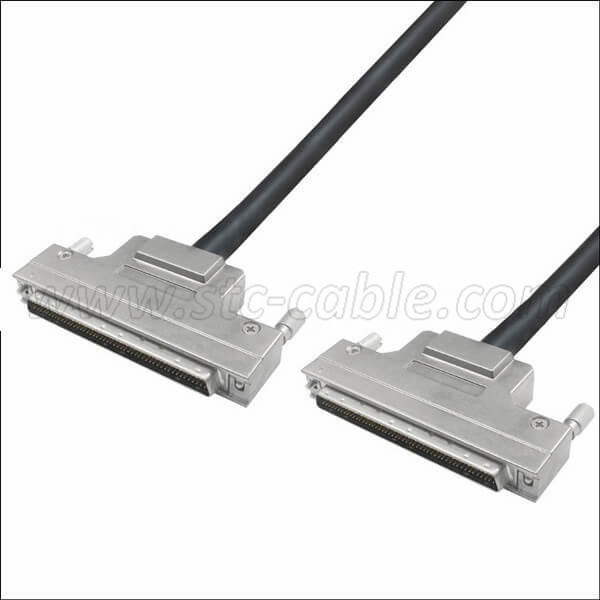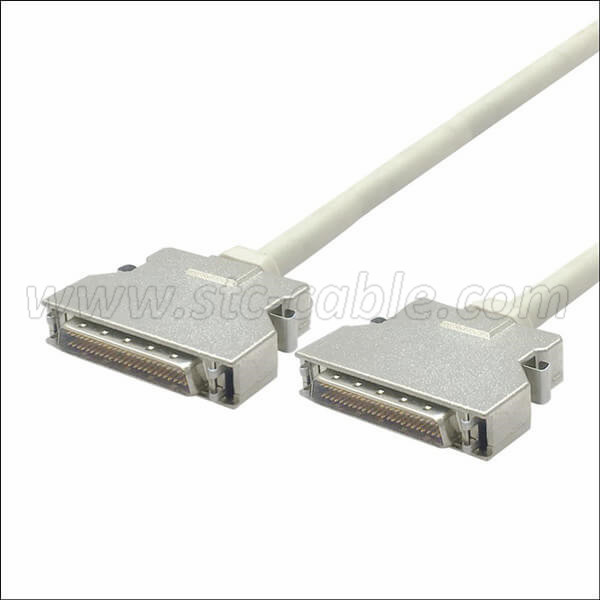SCSI cables are used for high-speed bus connections between small computers and intelligent peripherals such as hard disks, printers, and optical disks. SCSI stands for small computer system interface, a set of standards for physically connecting computers to peripherals and transferring data.
Examples of SCSI Cables
There are many varieties of SCSI cables, each with its own set of capabilities. Cables are typically broad and flat; however, you can also find more rounded ones. The following is by no means an exhaustive list of what you may encounter, but it can help demonstrate the many features that each one might provide.
SCSI-I
SCSI-I supports 1.5 Mbps asynchronous data transfer rates and 5 Mbps synchronous data transfer rates. SCSI-I features an 8-bit interface with a 50-pin connection that supports single-ended, open-collector storage.
SCSI-II
SCSI-II provides higher data transfer speeds, improved connections, a broader bus route, parity verification, and enhanced stability through synchronous negotiation.
The High Voltage Differential (HVD) was also incorporated into the SCSI-II standard to expand the length of a SCSI bus. The SCSI length limit increases to an unprecedented 25 meters with differential signaling. The cable uses a separate pin to ensure a correct transfer.
SCSI-III
SCSI-III supports higher data transfer speeds and upwards of 32 devices on one chain. In addition to the standard parallel interconnection of SCSI-II, it includes serial connectors. SCSI-III’s serial interconnection uses three innovations: serial storage architecture (SSA), Fibre Channel, and IEEE P1394. Also, serial transfer mode enables higher data speeds, more peripherals per bus, simple connectors, and lengthier cables.
You’ll also find that Ultra SCSI employs the SCSI-III standard for their cables. You can enhance throughput by extending the bus (Wide Ultra SCSI), raising the clock (Ultra2 SCSI), or both. Ultra3 SCSI is essentially a clock rate doubling to boost throughput, but it’s still a SCSI-III device and not a new type of SCSI.
Types of SCSI Cables
1> VHDCI 0.8mm 68-Pin
The Very High-Density Cable Interconnect (VHDCI) 0.8mm 68-pin connector has 68 pins arranged in two rows, one on top of the other. The top row has 34 pins, and the lower row has 34 pins, closely resembling that of a Centronics type interface. This connector is typically used in SCSI-3 applications such as RAID.
2> Centronics 50
The Centronics 50 connector has 50 pins arranged in two rows of 25 pins, one on top of the other. This connector is typically used in SCSI-1 applications such as older scanners, controllers, and external SCSI device cases.
3> Internal 50-Pin SCSI
The internal 50-pin SCSI connector has 50 pins arranged in two rows of 25 pins, one on top of the other. This connector is typically used in internal SCSI-1/SCSI-2 applications such as hard drives, CD-ROMs, and removable storage drives.
4> Internal 68-Pin SCSI
The internal 68-pin SCSI connector has 68 pins arranged in two rows of 34 pins, one on top of the other. This connector is typically used in internal SCSI-2/SCSI-3 applications such as hard drives, CD-ROMs, and removable storage drives.
5>Micro DB68
The Micro DB68 or MD68 connector has 68 pins arranged in two rows of 34 pins, one on top of the other. This connector is typically used in SCSI-3 applications such as scanners, removable storage drives, controllers, external CDR/CDRW, and Ultra/2. This connector is also known as High-Density, or HD 68, and Half-Pitch, or HP68.
6> Micro DB50
The Micro DB50 or MD50 connector has 50 pins arranged in two rows of 25 pins, one on top of the other. This connector is typically used in SCSI-2 applications such as scanners, removable storage drives, controllers, and external CDR/CDRW. This connector is also known as High-Density, or HD50, and Half-Pitch, or HP50.
7> Micro Centronics 50
The Micro Centronics 50 connector has 50 pins arranged in two rows of 25 pins, one on top of the other. This connector is typically used in proprietary SCSI-2 interface applications. This connector is rare.
8> DB50
The DB50 connector has 50 pins arranged in three rows, one on top of the other. The top row has 17 pins, the middle row has 16 pins, and the lower row has 17 pins. This connector is typically used in early SCSI applications, such as older Sun Sparcstations.
Send your message to us:
Post time: Oct-17-2023

